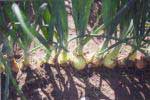 |
The quality of organic plant products
Summary
The aims of the project were:
- To obtain basic and strategic knowledge about the genetic background for the defence mechanisms of plants, so they can be optimised in future cultivars in combination with high yield and good baking quality in wheat, and thereby provide background for breeding and cultivation of cultivars, that are particularly well suited for organic production of bread and fodder.
- To develop and adjust methods for organic cultivation of oats, so Danish production of organic oat meal of high quality can commence.
- To describe and understand differences in quality among organically grown potatoes and thereby point out methods to produce organic potatoes with high eating quality and good raw material characteristics.
The project consisted of 3 parts, concerning wheat, oats and potatoes:
Subproject wheat (IV.4.1)
Strategic physiologic and genetic investigation of selected mechanisms for defence against weeds, insects (aphids) and pathogens (common bunt) in wheat, their correlations with each other and with baking quality of the grains. In each laboratory the same genotypes were to be tested, as far as possible a population of lines produced from a selected crossing. Parents were to be selected that had different allelopathic effect, and were then to be tested for insect resistance, baking quality and pathogen resistance. If none of these populations were useful, other research material was to be used, but the results of the project would then be more preliminary.
Results
A segregating population of DH-lines was established from a cross of the cultivars Club and Chul. However, testing of the population was not accomplished as expected within the project. The funds for testing were used up for method development and screening of cultivars before the material from the cross were ready for testing.
A large number of cultivars and accessions were tested for allelopatic effects on chickweed and perennial ryegrass, and significant differences were found among the cultivars, but only in a few cases different effects on the two weed species. The dose-response curve for relevant compounds (DIMBOA and vanillic acid, 4-hydroxybenzoic acid, ferulic acid and p-coumaric acid) was determined for 15 different weed species by measuring the effect on root length, and large differences were found among species and compounds. The measured exudation of the above mentioned compounds was far less than expected, and no correlation was observed among allelopathy, presence of DIMBOA, and level of resistance against common bunt in 21 cultivars, which comprised some with high and some with low allelopathic effects. The aphid experiments failed technically and no data were produced. Differences in characteristics related to baking quality are so large, that they should be taken into account when choosing cultivation method, cultivar choice and planning of breeding strategies, but no correlations were found with other characteristics.
Subproject oats (IV.4.2)
Applied investigation of the possibilities of growing oats of a quality that is suited for the production of oat meal. Planned content: Comparison of cultivars and cultivation strategies. Large kernels are needed, and a biochemical composition that prevents development of rancidity.
Results:
Comparison of four cultivars and single/double row distance showed that one of the tested cultivars give both good quality and acceptable yields in an organic crop rotation with low infection load, even though it does not possess nematode resistance. The good quality consists of a suitable and uniform kernel size for use in meal production. Row distance does not affect kernel size significantly. Measurement of gelatinising properties will be concluded during spring of 2001.
Subproject potatoes (IV.4.3)
Strategic-applied investigation of the quality of organic potatoes from the treatments of project II.3.
Results
Cultivation treatments gave less variation in sensory quality than the effects of cultivars and years. Deep litter gave the best quality but a smaller yield. When fertilised with slurry the potatoes had more discoloration and less yellow surface colour, the potato taste was less distinct and the potatoes were more moist (watery) than those fertilised with deep litter. Since some of the potentially plant protecting compounds (coumarins and phenolic acids) tend to give a bitter taste, these were also measured and the results compared with the sensory investigations. But the highest contents were found in some the samples fertilised with deep litter, which also had the best taste.
|